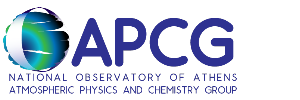According to the European Environmental Agency (EEA), 90% of the population in urban areas in Europe is exposed to harmful levels of air pollution, with concentrations of PM2.5 responsible for over 400,000 premature deaths in 2015. This is due to both local sources (industry, transport, fossil fuel combustion etc.) as well as transported anthropogenic or natural pollution (e.g. dust, wildfires). Although no minimum threshold is established of which below there are no health effects of exposure to air pollutants like particulate matter, EEA puts forth standards for air pollutants and the World Health Organization recommends guidelines per pollutant, both globally and for Europe.
Our research is geared towards the monitoring and modeling of gaseous and particulate pollutants, as well as the detection and measurement of chemical compounds that are harmful to the environment and public health. The focus is on the monitoring and city-scale modeling of pollutant concentrations, their spatial distribution and temporal trends and the deep understanding of the mechanisms/processes controlling their levels and variability.
Source: http://dx.doi.org/10.1016/j.scitotenv.2017.03.045
Our activities include:
- Investigation of diachronic air quality degradation in urban and pristine environments, source apportionment and evaluation of abatement strategies, as well as study of intense pollution events from specific sources
- Delineation of locally produced versus long range transported pollutants and support of decision making and reporting with respect to the Convention on Long-range Transboundary Air Pollution (LRTAP Convention)
- Determination of air pollution risks on cultural heritage (CH) by integrating aerosol remote sensing techniques and in situ measurements. Evaluation of indoor air quality in museums and other CH exhibition areas/storage rooms, considering the interaction with the ambient conditions.
- Air pollution monitoring, modeling and assessment as a result of related hazards/disasters like peri-urban forest fires and industrial accidents
- Measurement of Volatile Organic Compounds (VOC) to address questions such as the identification and quantification of their emission sources, the understanding of their role as ozone precursors and the contribution on secondary aerosol formation processes towards establishment of air pollution abatement measures
- Understanding of the reciprocal relations and combined effects between air quality and other urban pressures like noise, light pollution, green/blue spaces, urban sprawl/growth
- Application of Air Quality Indexes (AQIs) and monitoring of indicators that capture the impact of major gaseous and particulate pollutants on air quality.
- Application of city-scale numerical models to assess the levels of, spatial distribution of, and population exposure to gaseous and particulate atmospheric pollutants.
- Contribution to policy assessment, to improvement of development and/or of implementation of regulation, and coordination between stakeholders, to increase the resilience of cities to air pollution and bring the issue higher on the local, national and EU agendas, in alignment with the New Urban Agenda.


